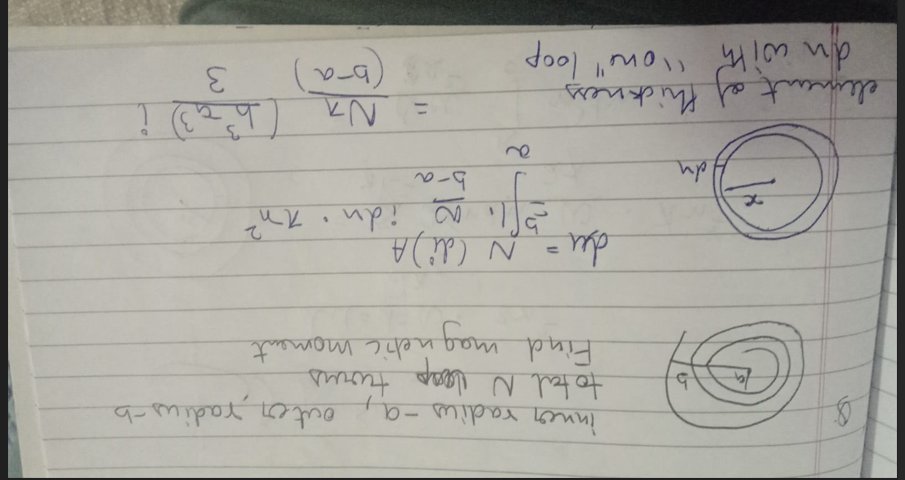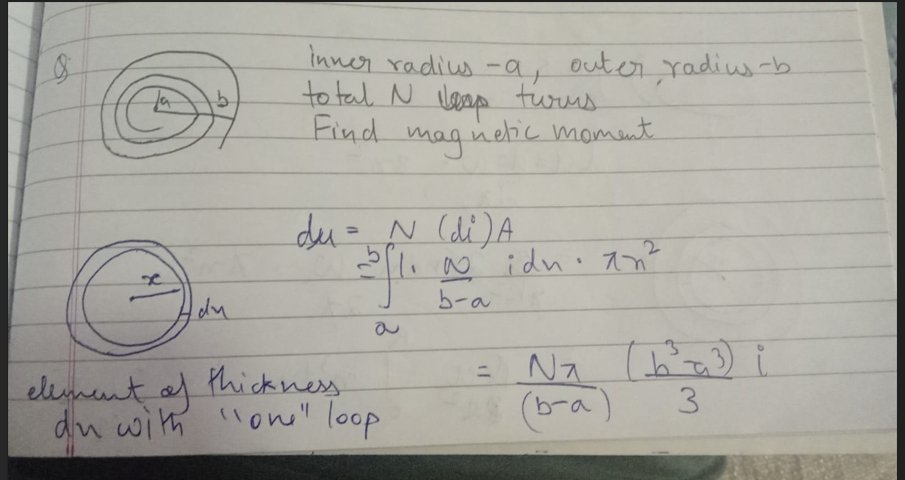magnetic moment
at angle theta from centre i take an element such that it has only one loop .
dM = di * pi d^2/4 = i/N * pi d^2/4
current per loop/turn = i/N
i take components and only sintheta ka contribution hoga
so M = integration dM sin theta
whats wrong besides the fact theres no dtheta

38 Replies
@Gyro Gearloose
Note for OP
+solved @user1 @user2... to close the thread when your doubt is solved. Mention the users who helped you solve the doubt. This will be added to their stats.dM = dN * i * A
di kyun lia ha
current to sbme same hai
dN = 500d@/pi
by unitary
d@ is d theta
0.5 ha kya answer
?
numerical ans mat de
my idea is to take only loop as element
Mt de matlab?
you can't take di
Ye nahi ha kya answer
idk if this will work.. better is to consider a small length to be the element with dn turns
Tbbhi di kyun liya ha
Ek loop ka current nikal kar N se multiply krlo
Area nikal lo
Ig aise bhi ajyega bina element liye
i was thinking of doing something like this

Ans kya ha fir @hardcoreisdead
bata dia toh ull seek that
Sahi baat ha
,rotate
,rotate


when you are writing N/(b-a)dx it considers all loops in the dx element right
ik u wanna consider one loop as the element
but how can u specifically choose an element like that
im confused
likewise over here you could've written N/pi times dtheta
like N/(b-a)dx , in case of toroid, it'd be N/pi times dtheta
it represent current in one loop
marked N i put as 1

uske baad wala N comes from di
but current is not gonna change
it's i through each loop
that's why N/b-a times dx which is right, actually is dN. the number of loops with current i in the small element you've taken
unless im mistaken.
even in the case of toroid, why would the current be di in one loop
it'd be i
baat toh shi hai
ill think a bit more on this and get back
yeah okay
@hardcoreisdead
0.7?
ek br confirm krdo ye nhi hua to im getting depressed :aah:
constants mein pata hai ans
Constants me NiA?
A is area of each turn
Nipir^2?
ans mein pi hi nahi hai
yeah ans is NI/2 times 25 *10^-4 perhaps
basically NI/2 (d^2) (if d is in m)
is this it @hardcoreisdead
yep
the derivation i've done is including dtheta
the one loop thing you told i dont really get
i did by assuming an element with dn rings
han mujhe bhi galat lag rhi woh
can u give a soln to this too
everything seems correct except this red box

it should dN * i
hmm like it's pretty much the same. I've assumed dx like what you did. But current will be i in every loop. So dN (no of rings in this dx) will be N/b-a times dx
yeah exactly
dN = N/(b-a) * dx
rest is fine
yeah that's right
and then times i and area